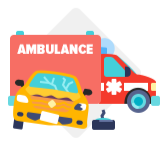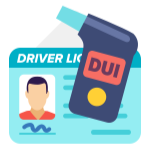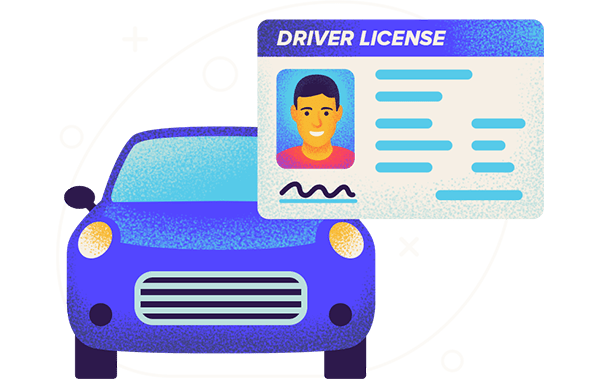Obtaining a driver’s license is often seen as a milestone in American culture — a symbol of independence and growing up. However, for thousands of teens each year, this milestone turns into a tragedy. Car crashes are the leading cause of death for individuals aged 16 to 19, a group that also faces the highest crash risk.
The financial toll is equally alarming. Crashes involving teens between 13 and 19 years old lead to approximately $40.7 billion annually in medical bills and lost productivity. This figure doesn’t even account for ongoing expenses like vehicle maintenance, rising insurance premiums, traffic tickets, and other related costs that can accumulate quickly.
To help parents protect both their teens and their wallets, WalletHub evaluated the teen-driving environment in all 50 states across 23 key metrics. Our data set ranges from the number of teen driver fatalities to the average cost of car repairs to the presence of impaired-driving laws.

Chip Lupo, WalletHub Analyst
Main Findings
Best States for Teen Drivers
| Overall Rank | State | Total Score | Safety Rank | Economic Environment Rank | Driving Laws Rank |
|---|---|---|---|---|---|
| 1 | New York | 72.25 | 2 | 23 | 2 |
| 2 | Oregon | 72.01 | 8 | 24 | 1 |
| 3 | New Jersey | 68.74 | 1 | 17 | 14 |
| 4 | West Virginia | 65.41 | 12 | 28 | 3 |
| 5 | Kentucky | 64.56 | 18 | 1 | 8 |
| 6 | Rhode Island | 63.79 | 11 | 26 | 7 |
| 7 | Indiana | 63.41 | 5 | 25 | 12 |
| 8 | Massachusetts | 62.42 | 3 | 22 | 22 |
| 9 | Washington | 62.24 | 14 | 46 | 4 |
| 10 | California | 59.94 | 7 | 50 | 11 |
| 11 | Maryland | 59.91 | 4 | 18 | 26 |
| 12 | Connecticut | 59.75 | 26 | 27 | 6 |
| 13 | Georgia | 59.74 | 13 | 45 | 13 |
| 14 | Alaska | 58.60 | 29 | 43 | 5 |
| 15 | Utah | 57.06 | 16 | 47 | 20 |
| 16 | Illinois | 56.34 | 22 | 30 | 18 |
| 17 | Minnesota | 55.66 | 15 | 10 | 36 |
| 18 | Hawaii | 55.26 | 20 | 12 | 28 |
| 19 | Louisiana | 54.95 | 42 | 3 | 9 |
| 20 | South Carolina | 54.65 | 37 | 39 | 10 |
| 21 | Kansas | 54.43 | 24 | 7 | 30 |
| 22 | Delaware | 54.19 | 34 | 15 | 21 |
| 23 | Florida | 54.06 | 17 | 20 | 37 |
| 24 | Texas | 53.73 | 33 | 16 | 25 |
| 25 | Pennsylvania | 53.72 | 31 | 38 | 17 |
| 26 | North Carolina | 53.53 | 23 | 19 | 34 |
| 27 | Vermont | 53.43 | 6 | 33 | 43 |
| 28 | Maine | 53.20 | 32 | 36 | 23 |
| 29 | Michigan | 53.20 | 9 | 2 | 46 |
| 30 | Arizona | 52.94 | 36 | 37 | 15 |
| 31 | Tennessee | 52.53 | 35 | 41 | 18 |
| 32 | Virginia | 52.46 | 19 | 49 | 27 |
| 33 | Ohio | 51.85 | 10 | 21 | 45 |
| 34 | Nevada | 51.37 | 25 | 44 | 32 |
| 35 | Iowa | 51.34 | 27 | 9 | 38 |
| 36 | Wisconsin | 50.96 | 21 | 34 | 39 |
| 37 | Colorado | 49.13 | 40 | 32 | 24 |
| 38 | New Hampshire | 49.07 | 30 | 14 | 40 |
| 39 | Oklahoma | 48.04 | 41 | 6 | 30 |
| 40 | New Mexico | 47.75 | 46 | 31 | 16 |
| 41 | Arkansas | 46.74 | 43 | 4 | 33 |
| 42 | South Dakota | 45.20 | 44 | 13 | 35 |
| 43 | Idaho | 44.46 | 28 | 48 | 44 |
| 44 | Alabama | 44.06 | 39 | 29 | 41 |
| 45 | Nebraska | 43.01 | 38 | 5 | 47 |
| 46 | North Dakota | 42.08 | 45 | 11 | 42 |
| 47 | Mississippi | 40.46 | 48 | 8 | 29 |
| 48 | Wyoming | 31.40 | 49 | 35 | 48 |
| 49 | Missouri | 27.64 | 47 | 40 | 50 |
| 50 | Montana | 23.00 | 50 | 42 | 49 |
Note: With the exception of “Total Score,” all of the columns in the table above depict the relative rank of that state, where a rank of 1 represents the best conditions for that metric category.

- Lowest
- 1. Hawaii
- 2. Nebraska
- 3. South Dakota
- 4. Colorado
- 5. Washington

- Highest
- 46. Texas
- 47. Illinois
- 48. West Virginia
- 49. Virginia
- 50. Maine

- Fewest
- 1. Rhode Island
- 2. New York
- 3. New Jersey
- 4. Hawaii
- 5. Massachusetts

- Most
- 46. Delaware
- 47. Arkansas
- 48. North Dakota
- 49. Montana
- 50. Wyoming

- Fewest
- 1. Kentucky
- 2. Delaware
- 3. Louisiana
- 4. Florida
- 5. New York

- Most
- T-46. North Dakota
- T-46. Alaska
- T-46. Wyoming
- T-46. Montana
- T-46. South Dakota

- Lowest
- 1. Maine
- 2. Ohio
- 3. Michigan
- 4. Iowa
- 5. Wisconsin

- Highest
- 46. North Carolina
- 47. Georgia
- 48. California
- 49. Colorado
- 50. Connecticut
In-Depth Look at the Best States for Teen Drivers
New York
New York is the best state for teen drivers, despite traffic congestion in its biggest cities, in large part due to the fact that it has the second-fewest teen driver fatalities per capita. In addition, New York has the fourth-lowest percentage of drivers who use phones while driving and the third-lowest prevalence of poor turning (turning while accelerating too much).
New York also has plenty of places to teach teens how to drive, with the most driving schools per capita. Teens seem to be taking their safety lessons to heart, since the state has the fifth-fewest teen DUI arrests per capita and the seventh-lowest share of teens who text while driving.
Finally, New York has nearly all of the optimal driving laws recommended by the Advocates for Highway and Auto Safety, and it has the seventh-highest auto insurance premium increases in the nation for high-risk drivers.
Oregon
Oregon is the second-best state for teen drivers, and it takes driving laws very seriously, with some of the highest fines in the country for running a red light or not wearing a seat belt. This encourages drivers – especially teen drivers with little money – to be as safe as possible on the road. It’s no surprise that over 96% of teens in the state always wear a seat belt.
Another important factor when learning how to drive is road quality, as having less experience can make it more difficult to deal with hazardous conditions. Oregon’s road quality is the seventh-best in the country.
The Beaver State has the second-lowest share of drivers who use phones while driving and the 9th-lowest share of drivers who speed, which further contributes to safety. All in all, Oregon has the 15th-lowest teen driver fatality rate in the country.
New Jersey
New Jersey is the third-best state for teen drivers, with strict driving laws and the third-most driving schools per capita. High insurance premiums for high-risk drivers reinforce this safety-first approach, with the state ranking sixth in the nation for rates increase.
When it comes to safety, the Garden State has the third-lowest teen driver fatality rate. New Jersey has the third-lowest percentage of teen drivers who drive under the influence of alcohol, and the 11th-lowest percentage who text while driving. Around 93% of teens always wear a seatbelt, too.
Ask the Experts
Although teens are responsible for their own actions, parents shoulder much of the emotional and financial consequences when things go south. In areas where teen deaths resulting from car crashes are most prevalent, it’s also up to lawmakers to implement programs and policies to reduce those numbers. For additional insight and advice, we asked a panel of experts to share their thoughts on the following key questions:
- What tips do you have for parents of teen drivers?
- What is the biggest risk that teen drivers face?
- What tips do you have for minimizing the costs (insurance, etc.) associated with having a teen driver in the household?
- Should we increase the age at which an individual is eligible for a license to 18?
- What should policymakers do to increase the safety of teen drivers?
Ask the Experts
Professor, Department of Psychological Sciences - Kent State University
Read More
Ph.D. – Past Chairman and Professor Emeritus, Civil and Environmental Engineering - University of Hawaii at Mānoa
Read More
Professor of the Practice, Carolyn A. and Peter S. Lynch School of Education and Human Development – Boston College
Read More
Ph.D., PE – Associate Professor, Department of Civil & Environmental Engineering, Swanson School of Engineering - University of Pittsburgh
Read More
Ph.D. – Professor and psychologist with UTHealth Houston
Read More
Ph.D., P.E. retired, Professor Emeritus, Dept of Civil and Environmental Engineering, University of Maine, Orono
Read More
Methodology
In order to determine the best and worst states for teen drivers, WalletHub analyzed the teen-driving environment in the 50 states across three key dimensions: 1) Safety, 2) Economic Environment and 3) Driving Laws.
We evaluated those dimensions using 23 relevant metrics, which are listed below with their corresponding weights. Each metric was graded on a 100-point scale, with a score of 100 representing the most favorable conditions for teen drivers. For metrics marked with an asterisk (*), the square root of the population was used to calculate the “Number of Residents” in order to avoid overcompensating for minor differences across states.
We then determined each state’s weighted average across all metrics to calculate its overall score and used the resulting scores to rank-order our sample.
Safety – Total Points: 50
- Teen Driver Fatalities per 100,000 Teens: Double Weight (~8.00 Points)
- Vehicle Miles Traveled per Capita: Half Weight (~2.00 Points)
- Traffic Indiscipline: Full Weight (~4.00 Points)
Note: This is a composite metric that measures incidents due to poor behavior: phone use, speeding, aggressive acceleration, harsh braking, and poor turning. - Teen “Under the Influence” Traffic Violations per 100,000 Teens: Full Weight (~4.00 Points)
- Share of Teen Drinking & Driving: Full Weight (~4.00 Points)
- Share of Teen Texting/Emailing While Driving: Full Weight (~4.00 Points)
- Share of Teenagers Aged 18 to 24 Always or Nearly Always Wearing a Seatbelt: Double Weight (~8.00 Points)
- Cost of Teen Crash-Related Deaths per 100,000 Teens: Full Weight (~4.00 Points)
- Quality of Roads: Double Weight (~8.00 Points)
- Driving Schools per Capita*: Full Weight (~4.00 Points)
Economic Environment – Total Points: 20
- Maximum Cost of Speeding Ticket: Half Weight (~1.33 Points)
- Maximum Cost of Red-Light Ticket: Half Weight (~1.33 Points)
- Maximum Amount of First-Offense Fines for Not Wearing Seat Belt: Half Weight (~1.33 Points)
- Premium Increase After Adding Teen Driver to Parent’s Auto-Insurance Policy: Double Weight (~5.33 Points)
- Average Cost of Car Repairs: Full Weight (~2.67 Points)
- Average Gas Prices: Double Weight (~5.33 Points)
- Punitiveness of Insurance Companies Toward High-Risk Drivers: Full Weight (~2.67 Points)
Note: This metric is based on WalletHub’s “States with the Highest & Lowest Insurance-Premium Penalties for High-Risk Drivers” ranking.
Driving Laws – Total Points: 30
- Provision of Teen Driver's Graduated Driver Licensing (GDL) Program Laws: Full Weight (~6.00 Points)
- Presence of Occupant-Protection Laws: Full Weight (~6.00 Points)
- Presence of Impaired-Driving Laws: Half Weight (~3.00 Points)
- Presence of Distracted-Driving/Texting-While-Driving Laws: Full Weight (~6.00 Points)
- Presence of Red-Light & Speeding-Camera Laws: Half Weight (~3.00 Points)
- Leniency Toward DUI Violations: Full Weight (~6.00 Points)
Note: This metric is based on WalletHub’s “Strictest & Most Lenient States on DUI” ranking.
Sources: Data used to create this ranking were collected as of July 29, 2025 from the U.S. Census Bureau, U.S. DEPARTMENT OF TRANSPORTATION - Federal Highway Administration, National Highway Traffic Safety Administration, EverQuote, Federal Bureau of Investigation, Advocates for Highway and Auto Safety, Centers for Disease Control and Prevention, The Road Information Program, CarMD, Insurance Institute for Highway Safety, CarInsurance.com, the Governors Highway Safety Association, American Automobile Association and WalletHub research.








WalletHub experts are widely quoted. Contact our media team to schedule an interview.